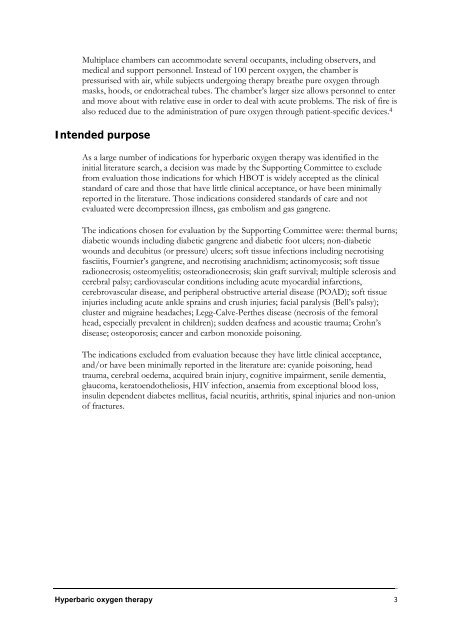Hyperbaric Oxygen Therapy - Hyperbaric Chamber Information ...
Hyperbaric Oxygen Therapy - Hyperbaric Chamber Information ...
Hyperbaric Oxygen Therapy - Hyperbaric Chamber Information ...
You also want an ePaper? Increase the reach of your titles
YUMPU automatically turns print PDFs into web optimized ePapers that Google loves.
Multiplace chambers can accommodate several occupants, including observers, and<br />
medical and support personnel. Instead of 100 percent oxygen, the chamber is<br />
pressurised with air, while subjects undergoing therapy breathe pure oxygen through<br />
masks, hoods, or endotracheal tubes. The chamber’s larger size allows personnel to enter<br />
and move about with relative ease in order to deal with acute problems. The risk of fire is<br />
also reduced due to the administration of pure oxygen through patient-specific devices. 4<br />
Intended purpose<br />
As a large number of indications for hyperbaric oxygen therapy was identified in the<br />
initial literature search, a decision was made by the Supporting Committee to exclude<br />
from evaluation those indications for which HBOT is widely accepted as the clinical<br />
standard of care and those that have little clinical acceptance, or have been minimally<br />
reported in the literature. Those indications considered standards of care and not<br />
evaluated were decompression illness, gas embolism and gas gangrene.<br />
The indications chosen for evaluation by the Supporting Committee were: thermal burns;<br />
diabetic wounds including diabetic gangrene and diabetic foot ulcers; non-diabetic<br />
wounds and decubitus (or pressure) ulcers; soft tissue infections including necrotising<br />
fasciitis, Fournier’s gangrene, and necrotising arachnidism; actinomycosis; soft tissue<br />
radionecrosis; osteomyelitis; osteoradionecrosis; skin graft survival; multiple sclerosis and<br />
cerebral palsy; cardiovascular conditions including acute myocardial infarctions,<br />
cerebrovascular disease, and peripheral obstructive arterial disease (POAD); soft tissue<br />
injuries including acute ankle sprains and crush injuries; facial paralysis (Bell’s palsy);<br />
cluster and migraine headaches; Legg-Calve-Perthes disease (necrosis of the femoral<br />
head, especially prevalent in children); sudden deafness and acoustic trauma; Crohn’s<br />
disease; osteoporosis; cancer and carbon monoxide poisoning.<br />
The indications excluded from evaluation because they have little clinical acceptance,<br />
and/or have been minimally reported in the literature are: cyanide poisoning, head<br />
trauma, cerebral oedema, acquired brain injury, cognitive impairment, senile dementia,<br />
glaucoma, keratoendotheliosis, HIV infection, anaemia from exceptional blood loss,<br />
insulin dependent diabetes mellitus, facial neuritis, arthritis, spinal injuries and non-union<br />
of fractures.<br />
<strong>Hyperbaric</strong> oxygen therapy 3



